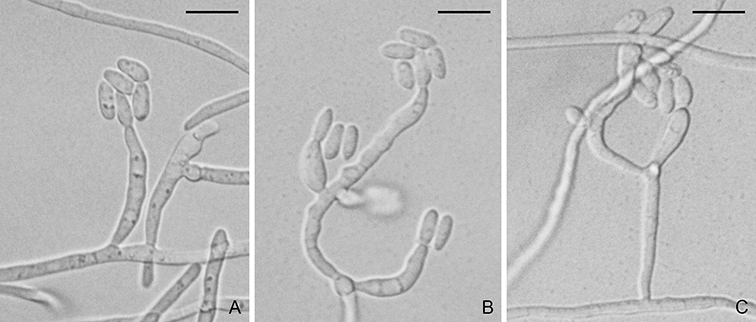
Figure. Pseudophialophora schizachyrii (AL3s4). A–C. Conidiophores and conidia. Scale bars: A–C = 10 µm.
Pseudophialophora schizachyrii J. Luo & N. Zhang.
MycoBank: MB807083.
Asexual state phialophora-like. On CMA, hyphae branched, septate, hyaline to yellowish, smooth. Conidiophores micronematous, single or branched. Conidiogenous cells phialidic, curved, hyaline to yellowish, 3–23 × 2.5–3.7. Conidia aggregated in slimy heads, ellipsoidal, straight or slightly curved, aseptate, hyaline, smooth, 5.5–8 × 2.5–3.5 µm. Sexual state unknown.
Colonies on PDA 2.2 cm diam after 7 days at 25 °C in dark; surface velvety, sulphine yellow; aerial mycelium yellowish; reverse orange citrine. Colonies on CMA 1.8 cm after 7 days at 25 °C in dark; surface aniline yellow; aerial mycelium sparse; reverse pyrite yellow (Description from Luo et al., 2014).
Typification: Holotype RUTPPAL3s4. Ex-holotype culture AL3s4.
Gene sequences: KF689600 (18S), KF689650 (ITS), KF689640 (28S), KF689610 (MCM7), KF689620 (RPB1), KF689630 (TEF1).
Genome sequences: SRX798637 (transcriptome).
Specimens examined: USA, New Jersey, Assunpink Lake, N40 12.962, W74 30.527, 40 m, from roots of Poaceae, 30 Aug. 2012, J. Luo and N. Zhang, RUTPPAL3s4; ibid., from roots of Schizachyrium, 30 Aug. 2012, J. Luo and N. Zhang, RUTPPAL2m1.
Hosts/substrates: From roots of Schizachyrium and other species of Poaceae.
Distribution: USA (New Jersey).
Copyright 2022 by The American Phytopathological Society. Reproduced, by permission, from Luo, J., and Zhang, N. 2022. The Rice Blast Fungus and Allied Species: A Monograph of the Fungal Order Magnaporthales (https://my.apsnet.org/APSStore/Product-Detail.aspx?WebsiteKey=2661527A-8D44-496C-A730-8CFEB6239BE7&iProductCode=46826). American Phytopathological Society, St. Paul, MN.